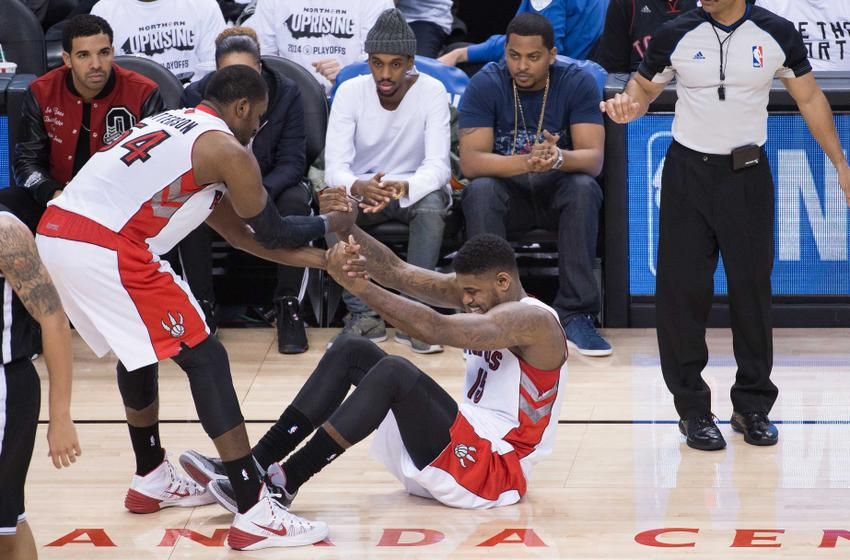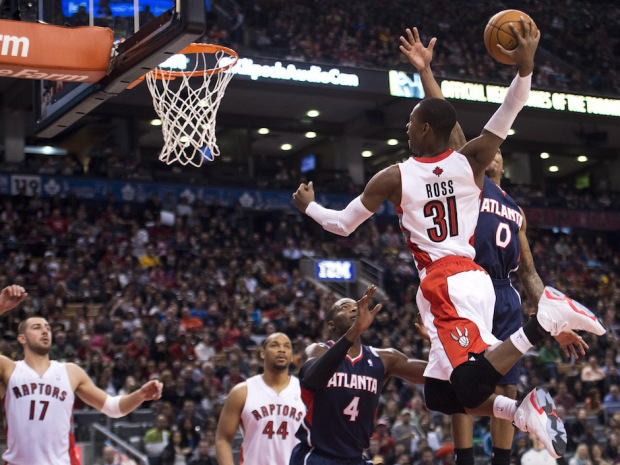Two halves of one whole.
As compared to basketball, platoons are more prevalent in baseball. The strategy is as old as the game itself. Some hitters dominate righties, but are helpless against lefties, vice-versa for others. It only makes sense to pair up two players with complementary skillsets. Two otherwise flawed players can combine to make a position of weakness into a strength. The Boston Red Sox successfully rode the pairing of Jonny Gomes and Daniel Nava sharing duties in left field to a World Series in 2013.
Amir Johnson and Patrick Patterson are the Raptors’ basketball equivalent of a platoon. Neither player has demonstrated over the course of their careers that they can shoulder a full-time starting power forward workload, and both players have their flaws. But much like a platoon, their strengths complement one another, allowing for their impact to be maximized through smart in-game management.
Strengths on offense
Patterson is a floor-spacer. He sunk 41.1 percent of his three-pointers last season, a mark on-par with the elite at his position. Ryan Anderson of the Pelicans connected on 40.9 percent of his triples. Channing Frye of the Suns sunk 37 percent. The ability to stretch the floor from a front-court position helps open up driving lanes for his teammates by pulling his defender out of the paint. Ian Levy recently wrote about Patterson’s impact on his teammates on offense. Long story short, most players shot a higher percentage with Patterson on the floor including DeMar DeRozan, who experienced a 6 percent bump in Patterson’s presence. Even though Patterson isn’t a good passer or dribbler, his shooting helps make plays for the Raptors.
Johnson, on the other hand, is sometimes hard to notice on offense because he’s so often involved in facilitating the process of plays, rather than producing the result. He’s the opposite of DeRozan, in that sense. Johnson is one of the league’s best screen-setters, and runs a wicked two-man game with DeRozan. Johnson is crafty and understands how to open up space. He’s also a tremendous finisher in the pick-and-roll. He scored 1.09 points per pick-and-roll last season, placing him in the 90th percentile.
Strengths on defense
Patterson isn’t necessarily a bad defender. For the most part, he’s in the right place and stays attentive. Having said that, defense for front-court players has evolved to the point where the majority of possessions are help scenarios. That’s where Patterson struggles. He allowed 1.15 points per pick-and-roll from the opposing big last season. Patterson is also a fairly ineffective rim-protector. Opponents sunk 54.5 percent of their baskets around the rim last season in Patterson’s presence. On the whole, Patterson is average. His ESPN’s Real Plus-Minus, for example, is 1.11, on par with relative blasse defenders like Frye (1.17) and Zach Randolph (1.03).
Johnson is the superior defender. By DRPM, Johnson ranked 5th among all power forwards who played more than 20 minutes per game. He especially excels in help defense scenarios, where Johnson placed in the 99th percentile in terms of points allowed per pick-and-roll. Johnson slides himself into the right position to provide help and challenge shots. Despite being undersized and playing a fair share of his minutes at center, Johnson held opponents to 47.9 percent shooting at the rim. Johnson isn’t given credit for his rim-protection because he doesn’t record very many blocks, but consider this: Tim Duncan (47.6 percent) and Dwight Howard (48.1 percent) posted very similar opponent field-goal percentage at the rim figures. Not bad company for Johnson, who only stands at 6-foot-9.
Statistical Profile
Division of labor
In all likelihood, Johnson will be the starter and Patterson will back him up, though it’s a fair bet that both will share the court at some points as well. Although Patterson helps open up room for Valanciunas to operate in the post, Johnson provides a much needed presence in help defense scenarios. Valanciunas has developed to the point where he’s comfortable in staying at home to guard the rim but someone needs to play the role of active helper.
The luxury of having a platoon situation, however, is the ability to mix-and-match. If the Raptors are facing a rim-protector like Serge Ibaka, Patterson should play to open the interior. If instead, the Raptors are up against a pair of creaky, immobile defenders — like Amar’e Stoudemire and Andrea Bargnani for example — Johnson might be a better choice. Head coach Dwane Casey has options.
Best case scenario
Patterson — The career-high three-point percentage from last season wasn’t a fluke and he continues to excel in a bench capacity, garnering Sixth Man of the Year votes. A full training camp pays off and Patterson adapts to Casey’s defensive schemes. More time practising offense leads to more plays for Patterson than simple pick-and-pops. He duplicates Phoenix Suns forward Markieff Morris’ performance from last season.
Johnson — Miraculously, Johnson doesn’t twist his ankle every single game. He hits his prime at age 28 and plays a pseudo Tyson Chandler circa. 2011-12, shutting down pick-and-rolls while moving opposing defenders like pawns with his cutting. With Patterson playing so well, Casey doesn’t feel the need to overplay Johnson, and is therefore healthy for the playoffs.
Worst case scenario
Patterson — Fun fact: Patterson has only ever managed to play a full season once, and that was in a lockout shortened season. Injuries hit Patterson and he misses 20 games. His hot shooting from last year also turns out to be a mirage. He’s back to being just a pick-and-popping mid-range player, more Brandon Bass than Channing Frye.
Johnson — Real talk: Amir twists his ankles until his legs are nothing but twizzlers. He only misses five games, but plays hurt for much of the season. Patterson’s injury and the hole at back up center forces Amir to top 30 minutes per game for the first time in his career. As a result, he’s worn out by the time the playoffs come around and the Raptors have one less body to throw at an overrated sixth-seeded Charlotte Hornets.
Realistic projection
Patterson — Misses 10 games due to minor injuries. Produces a similar rate to last season, but three-point percentage dips. 10 points, 5 rebounds per game on 38 percent shooting from deep.
Johnson — Misses 10 games due to minor injuries. Plays fewer minutes per game due to Patterson and Valanciunas’ increase in roles. 10 points, 7 rebounds on 58 percent shooting overall. Attempts 100 threes, mostly from the corners.




